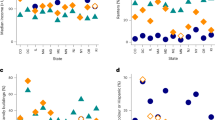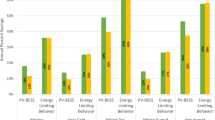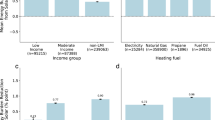Abstract
Each year, millions of Americans experience energy insecurity, or the inability to afford enough energy to meet their basic needs. This study evaluates whether residential rooftop solar can serve as a preventative solution to energy insecurity among low- to moderate-income households. Using a national, matched sample of solar and non-solar households based on detailed and address-specific data, we find that solar leads to large, robust and salient reductions in five indicators of energy insecurity. Moreover, the benefits of solar ‘spill over’ to improve a household’s ability to pay other energy bills. The results suggest that rooftop solar may be an effective tool for policymakers who seek to reduce energy insecurity.
This is a preview of subscription content, access via your institution
Access options
Access Nature and 54 other Nature Portfolio journals
Get Nature+, our best-value online-access subscription
$32.99 / 30 days
cancel any time
Subscribe to this journal
Receive 12 digital issues and online access to articles
$119.00 per year
only $9.92 per issue
Buy this article
- Purchase on SpringerLink
- Instant access to full article PDF
Prices may be subject to local taxes which are calculated during checkout


Similar content being viewed by others
Data availability
The data collected by the survey and analysed in the study are available via Dataverse at https://doi.org/10.7910/DVN/4HUD1Q. Any identifiable information has been removed from survey responses.
Code availability
The code used to analyse the survey data is available via Dataverse at https://doi.org/10.7910/DVN/4HUD1Q.
References
2020 RECS Survey Data: Consumption and Expenditures (US Energy Information Administration, 2021).
Carley, S., Graff, M., Konisky, D. M. & Memmott, T. Behavioral and financial coping strategies among energy-insecure households. Proc. Natl Acad. Sci. USA 119, e2205356119 (2022).
Cong, S., Nock, D., Qiu, Y. L. & Xing, B. Unveiling hidden energy poverty using the energy equity gap. Nat. Commun. 13, 2456 (2022).
Huang, L., Nock, D., Cong, S., & Qiu, Y. Inequalities across cooling and heating in households: energy equity gaps. Energy Policy 182, 113748 (2023).
Bhattacharya, J., DeLeire, T., Haider, S. & Currie, J. Heat or eat? Cold-weather shocks and nutrition in poor American families. Am. J. Public Health 93, 1149–1154 (2003).
Memmott, T., Carley, S., Graff, M. & Konisky, D. M. Sociodemographic disparities in energy insecurity among low-income households before and during the COVID-19 pandemic. Nat. Energy 6, 186–193 (2021).
Brown, M. A., Soni, A., Lapsa, M. V., Southworth, K. & Cox, M. High energy burden and low-income energy affordability: conclusions from a literature review. Prog. Energy 2, 042003 (2020).
Hernandez, D., Aratani, Y. & Jiang, Y. Energy Insecurity among Families with Children (Columbia Univ., 2014).
Konisky, D. M., Carley, S., Graff, M. & Memmott, T. The persistence of household energy insecurity during the COVID-19 pandemic. Environ. Res. Lett. 17, 104017 (2022).
Murray, A. G. & Mills, B. F. The impact of low-income home energy assistance program participation on household energy insecurity. Contemp. Econ. Policy 32, 811–825 (2014).
Eisen, J. B. COVID-19 and energy justice: utility bill relief in Virginia annual survey of Virginia law. Univ. Richmond Law Rev. 57, 155–196 (2022).
Baker, S. H., Carley, S. & Konisky, D. M. Energy insecurity and the urgent need for utility disconnection protections. Energy Policy 159, 112663 (2021).
Flaherty, M., Carley, S. & Konisky, D. M. Electric utility disconnection policy and vulnerable populations. Electr. J. 33, 106859 (2020).
Memmott, T., Carley, S., Graff, M. & Konisky, D. M. Utility disconnection protections and the incidence of energy insecurity in the United States. iScience 26, 106244 (2023).
Tonn, B., Rose, E. & Hawkins, B. Evaluation of the US Department of Energy’s weatherization assistance program: impact results. Energy Policy 118, 279–290 (2018).
Cook, J. J. & Shah, M. Reducing Energy Burden with Solar: Colorado’s Strategy and Roadmap for States (National Renewable Energy Laboratory, 2018)
Agdas, D. & Barooah, P. On the economics of rooftop solar PV adoption. Energy Policy 178, 113611 (2023).
Crago, C. L., Grazier, E. & Breger, D. Income and racial disparities in financial returns from solar PV deployment. Energy Econ. 117, 106409 (2023).
Bird, S. & Hernández, D. Policy options for the split incentive: increasing energy efficiency for low-income renters. Energy Policy 48, 506–514 (2012).
Riley, B. et al. Connected: rooftop solar, prepay and reducing energy insecurity in remote Australia. Aust. Geogr. 54, 325–346 (2023).
Forrester, S. P., Montañés, C. C., O’Shaughnessy, E. & Barbose, G. Modeling the potential effects of rooftop solar on household energy burden in the United States. Nat. Commun. 15, 4676 (2024).
Baker, E. et al. Metrics fo rdecision-making in energy justice. Annu. Rev. Environ. Resour. 48, 737–760 (2023).
Imai, K., King, G. & Stuart, E. A. Misunderstandings between experimentalists and observationalists about causal inference. J. R. Stat. Soc. 171, 481–502 (2008).
Cochran, W. G. The effectiveness of adjustment by subclassification in removing bias in observational studies. Biometrics 24, 295–313 (1968).
Ho, D. E., Imai, K., King, G. & Stuart, E. A. Matching as nonparametric preprocessing for reducing model dependence in parametric causal inference. Polit. Anal. 15, 199–236 (2007).
Stuart, E. A. Matching methods for causal inference: a review and a look forward. Stat. Sci. 25, 1–21 (2010).
Qiu, Y., Kahn, M. E. & Xing, B. Quantifying the rebound effects of residential solar panel adoption. J. Environ. Econ. Manag. 96, 310–341 (2019).
Deng, G. & Newton, P. Assessing the impact of solar PV on domestic electricity consumption: exploring the prospect of rebound effects. Energy Policy 110, 313–324 (2017).
Directory of state low- and moderate-income clean energy programs. Clean Energy States Alliance https://www.cesa.org/resource-library/resource/directory-of-state-low-and-moderate-clean-energy-programs/ (2021).
Proudlove, A. et al. The 50 States of Solar: Q1 2024 Quaterly Report (North Carolina Clean Energy Technology Center, 2024).
Savarani, S. & Spiegel-Feld, D. Equitable electrification: could city and state policies aggravate energy insecurity? Environ. Law Rep. 52, 10831–10846 (2022).
Do, V. et al. Spatiotemporal distribution of power outages with climate events and social vulnerability in the USA. Nat. Commun. 14, 2470 (2023).
Forrester, S., Barbose, G., O’Shaughnessy, E., Darghouth, N. & Montañés, C. C. Residential Solar-Adopter Income and Demographic Trends: 2023 Update (Energy Markets and Policy, 2023).
Barbose, G., Darghouth, N., O’Shaughnessy, E. & Forrester, S. Tracking the Sun: Pricing and Design Trends for Distributed Phovoltaic Systems in the United States, 2024 Edition (Energy Markets and Policy, 2024).
Sigrin, B. & Mooney, M. Rooftop Solar Technical Potential for Low-to-Moderate Income Households in the United States (National Renewable Energy Laboratory, 2018).
O’Shaughnessy, E., Barbose, G., Kannan, S. & Sumner, J. Evaluating community solar as a measure to promote equitable clean energy access. Nat. Energy 9, 955–963 (2024).
Borenstein, S. Private net benefits of residential solar PV: the role of electricity tariffs, tax incentives, and rebates. J. Assoc. Environ. Resour. Econ. 4, S85–S122 (2017).
Lukanov, B. R. & Krieger, E. M. Distributed solar and environmental justice: exploring the demographic and socio-economic trends of residential PV adoption in California. Energy Policy 134, 110935 (2019).
O’Shaughnessy, E., Barbose, G., Wiser, R. & Forrester, S. Income-targeted marketing as a supply-side barrier to low-income solar adoption. iScience 24, 103137 (2021).
Angrist, J. & Pischke, J.-S. Mostly Harmless Econometrics: an Empiricist’s Companion (Princeton Univ. Press, 2009).
Imbens, G. W. Nonparametric estimation of average treatment effects under exogeneity: a review. Rev. Econ. Stat. 86, 4–29 (2004).
Stuart, E. & Rubin, D. Best practices in quasi–experimental designs: matching methods for causal inference. In Best Practices in Quasi–experimental Designs: Matching Methods for Causal Inference (ed. Osborne, J.) 155–176 (Sage, 2008).
Cunningham, S. Causal Inference: the Mixtape (Yale Univ. Press, 2021).
Rubin, D. B. Using propensity scores to help design observational studies: application to the tobacco litigation. Health Serv. Outcomes Res. Methodol 2, 169–188 (2001).
Imai, K. & Khanna, K. Improving ecological inference by predicting individual ethnicity from voter registration records. Polit. Anal. 24, 263–272 (2016).
Homeland Infrastructure Foundation Level Database (Oak Ridge National Laboratory, 2023).
Annual Electric Power Industry Report, Form EIA-861 Detailed Data Files (US Energy Information Administration, 2022).
American Community Survey (US Census Bureau, 2023).
Methodology for Determining FY 2021 Section 8 Income Limits (US Department of Housing and Urban Development, 2021).
Cohen, J. Statistical Power Analysis for the Behavioral Sciences (Routledge, 1988).
Austin, P. C. & Stuart, E. A. Moving towards best practice when using inverse probability of treatment weighting (IPTW) using the propensity score to estimate causal treatment effects in observational studies. Stat. Med. 34, 3661–3679 (2015).
Acknowledgements
This work was funded by the US Department of Energy’s Office of Energy Efficiency and Renewable Energy under Solar Energy Technologies Office agreement number 38444 and contract no. DE-AC02-05CH1123, received by G.B. The Energy Justice lab at Indiana University and the University of Pennsylvania was funded through a subcontract with Lawrence Berkeley National Laboratory, received by S.C. and D.M. The authors also acknowledge that access to CoreLogic data was supported by a grant from the Racial Justice Research Fund at Indiana University, and that high performance computing resources were provided in part by Lilly Endowment, Inc., through its support for the Indiana University Pervasive Technology Institute.
Author information
Authors and Affiliations
Contributions
S.C., D.M.K. and G.B. conceived of the project. M.Y. led the analysis and writing. G.B., S.C., S.P.F., D.M.K., T.M., C.C.M. and E.O. contributed to the analysis and writing.
Corresponding author
Ethics declarations
Competing interests
The authors declare no competiting interests.
Peer review
Peer review information
Nature Energy thanks C. Clase, S. Farrar and A. Harker Steele for their contribution to the peer review of this work.
Additional information
Publisher’s note Springer Nature remains neutral with regard to jurisdictional claims in published maps and institutional affiliations.
Supplementary information
Supplementary Information
Supplementary Note, Tables 1–16 and Figs. 1–3.
Rights and permissions
Springer Nature or its licensor (e.g. a society or other partner) holds exclusive rights to this article under a publishing agreement with the author(s) or other rightsholder(s); author self-archiving of the accepted manuscript version of this article is solely governed by the terms of such publishing agreement and applicable law.
About this article
Cite this article
Yozwiak, M., Barbose, G., Carley, S. et al. The effect of residential solar on energy insecurity among low- to moderate-income households. Nat Energy 10, 569–580 (2025). https://doi.org/10.1038/s41560-025-01730-y
Received:
Accepted:
Published:
Issue date:
DOI: https://doi.org/10.1038/s41560-025-01730-y
This article is cited by
-
Solar and batteries are affordable options for US households
Nature Energy (2025)
-
Rooftop solar and energy storage programs can remediate energy-limiting behaviors of energy insecure households in the United States
Communications Earth & Environment (2025)



